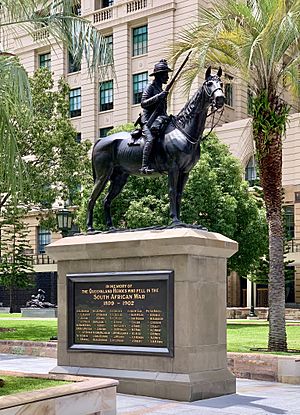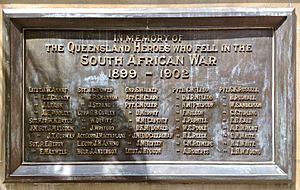South African War Memorial, Brisbane facts for kids
Quick facts for kids South African War Memorial, Brisbane |
|
|---|---|

The Scout, 2020
|
|
| Location | ANZAC Square, 228 Adelaide Street, Brisbane City, City of Brisbane, Queensland, Australia |
| Design period | 1900–1914 (early 20th century) |
| Built | 1912–1919 |
| Architect | James Laurence Watts |
| Official name: South African War Memorial, Boer War Memorial | |
| Type | state heritage (built) |
| Designated | 21 October 1992 |
| Reference no. | 600060 |
| Significant period | 1912–1939 (historical, fabric) (relocated 1939) 1912- (social) |
| Significant components | memorial – statue |
| Sculptor | James Laurence Watts |
| Lua error in Module:Location_map at line 420: attempt to index field 'wikibase' (a nil value). | |
The South African War Memorial is a special statue located in Anzac Square in Brisbane City, Queensland, Australia. It remembers the soldiers from Queensland who fought in the Second Boer War in South Africa. This memorial is also known as the Boer War Memorial or The Scout. It was created by a sculptor named James Laurence Watts between 1912 and 1919.
Contents
History of the South African War Memorial
Queensland Soldiers in the Boer War
The Second Boer War (1899-1902) was the first time soldiers from colonial Queensland fought overseas. The Queensland Government sent volunteer soldiers to help the British forces in South Africa. Sadly, 89 Queenslanders died during this war.
After the war, a group of people wanted to build a memorial to remember those who died. However, they didn't collect enough money, so the project stopped for a while.
Creating The Scout Statue
In 1912, James Laurence Watts, a sculptor from Brisbane, was asked to create a bronze statue of a soldier on horseback. His design had to be checked by experts in art, animal care, building design, and military matters.
The statue shows a Queensland mounted soldier fully equipped for the war. It was sent to England to be made into bronze. But World War I started, which delayed its return to Australia. Watts also made another memorial in London for Queenslanders who died in South Africa.
Unveiling and Relocation of the Memorial
Finally, in 1919, the finished statue, known as The Scout, came back to Brisbane. It was placed on a tall stone base at the corner of Turbot and Edward Streets. It faced the City Botanic Gardens and was a very noticeable landmark.
The base for the statue was built by a local company called Lowther & Sons. The Governor of Queensland, Sir Hamilton Goold-Adams, officially revealed the memorial in December 1919.
Every year on May 31st, the African War Veterans Association of Queensland held marches to the statue. This day was the anniversary of the peace treaty that ended the war in South Africa. They would have special services at the memorial.
In 1930, Anzac Square was created. The war veterans wanted the memorial moved there. In April 1939, it was moved to Anzac Square, just in time for the Anzac Day ceremonies. Lowther & Sons helped put the base back together in its new spot.
Today, the memorial still stands proudly in Anzac Square, facing Adelaide Street. In 1991, the Returned Services League helped restore the statue to keep it looking good.
What the Memorial Looks Like
The memorial is a life-size bronze statue of a Queensland Mounted Infantryman. The sculptor paid close attention to every small detail. You can see the Queensland hat-badge and emu feathers on the soldier's hat. Even the horse has the "QG" (Queensland Government) brand mark.
On two sides of the stone base, there are large bronze plaques. These plaques list the names of the 89 Queensland soldiers who died in the South African War.
Why This Memorial is Important
The South African War Memorial is a very important historical site in Queensland. It was added to the Queensland Heritage Register on October 21, 1992.
- It is the only memorial in Brisbane that remembers all the Queensland soldiers who died in the South African conflict.
- It shows how Queenslanders felt strongly about their identity and their connection to the British Empire after Australia became a nation.
- The memorial is a special example of the work of Brisbane sculptor J. L. Watts.
- It is part of a group of important war memorials in Anzac Square that mean a lot to the public.



